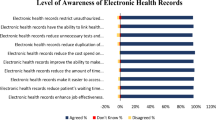Abstract
This paper presents action research results on critical features that impact the implementation and acceptance of Electronic Patient Records Management Systems (EPRMS) by health facilities. The paper also discusses automation approaches as well as initial benefits reported by health facilities. The EPRMS is in use by over 15 health facilities in Uganda. The goal is to create a paperless environment for a group of health facilities in a resource constrained environment. The EPRMS incorporates features for Electronic Patient Records (EPR), Electronic Medical Records (EMR) and Hospital Management. A phased-roll out approach was used as a way to ease challenges of insufficient resources such as computers, unstable local area network, frequent power outages and skills-gap among others. The first phase covered Outpatient Departments (OPD) for production deployment while Inpatients, Maternal and Child Health(MCH), HIV/AIDS care centres are setup in training mode awaiting the next phase of roll out. After a year of use, we administered a questionnaire to understand the impact and challenges of EPRMS. The respondents were hospital administrators and managers. In addition to the questionnaire, the Uganda Catholic Medical Bureau (UCMB) has its internal annual reporting process. The results reported are from the questionnaire, UCMB internal reporting, our observations and interactions with key stakeholders during implementation. Our finding indicate EMR and EPR functionality are not highly rated by hospital managers while Hospital Management features are considered important.
This work was funded by CORDAID http://cordaid.org as part of funding to UCMB under the Connect for Change Consortium (C4C).
Access this chapter
Tax calculation will be finalised at checkout
Purchases are for personal use only
Preview
Unable to display preview. Download preview PDF.
Similar content being viewed by others
References
Braa, J., and Humberto, M. Building collaborative networks in africa on health information systems and open source software development–experiences from the hisp/beanish network. IST Africa 3 (2007)
Care2x.org. The open source hospital information system, August 20015. http://care2x.org
Chetley, A., Davies, J., Trude, B., McConnell, H., and Ramirez, R. Improving health connecting people: the role of icts in the health sector of developing countries
Decimalworks.com. Helecare - hospital information system, August 20015. http://www.ucmb.co.ug/
DesRoches, C. M., Charles, D., Furukawa, M. F., Joshi, M. S., Kralovec, P., Mostashari, F., Worzala, C., and Jha, A. K. Adoption of electronic health records grows rapidly, but fewer than half of us hospitals had at least a basic system in 2012. Health Affairs (2013), 10–1377
Drury, P., and Dahlman, B. Open source approaches to health information systems in kenya. World Hospitals and Health Services 41, 3 (2005), 36.
Gladwin, J., Dixon, R., and Wilson, T. Implementing a new health management information system in uganda. Health Policy and Planning 18, 2 (2003), 214–224.
International, F. G. Iqcare, 2015. Website. https://fgiqcare.codeplex.com/
Jensen, P. B., Jensen, L. J., and Brunak, S. Mining electronic health records: towards better research applications and clinical care. Nature Reviews Genetics 13, 6 (2012), 395–405.
Khan, S. Z., Shahid, Z., Hedstrom, K., and Andersson, A. Hopes and fears in implementation of electronic health records in bangladesh. The Electronic Journal of Information Systems in Developing Countries 54 (2012)
Kiberu, V. M., Matovu, J. K., Makumbi, F., Kyozira, C., Mukooyo, E., and Wanyenze, R. K. Strengthening district-based health reporting through the district health management information software system: the ugandan experience. BMC medical informatics and decision making 14, 1 (2014), 40.
Kintu, P., Nanyunja, M., Nzabanita, A., and Magoola, R. Development of hmis in poor countries: Uganda as a case study
Lutwama, A. K. Uganda national e-health technology framework, 2012. Website. http://library.health.go.ug
McInnes, D. K., Saltman, D. C., and Kidd, M. R. General practitioners’ use of computers for prescribing and electronic health records: results from a national survey. Medical Journal of Australia 185, 2 (2006), 88.
Organization, W. H., et al. Strengthening accountability chains for maternal, newborn and child health in uganda–mtrac
Raghupathi, W., and Tan, J. Strategic it applications in health care. Communications of the ACM 45, 12 (2002), 56–61.
Reason, P., and Bradbury, H. Handbook of action research: Participative inquiry and practice. Sage, 2001
Ribière, V., LaSalle, A. J., Khorramshahgol, R., and Gousty, Y. Hospital information systems quality: a customer satisfaction assessment tool. In Systems Sciences, 1999. HICSS-32. Proceedings of the 32nd Annual Hawaii International Conference on (1999), IEEE, pp. 7–pp
ucmb.co.ug. History of uganda catholic medical bureau, May 2015. http://www.ucmb.co.ug/
Author information
Authors and Affiliations
Corresponding author
Editor information
Editors and Affiliations
Rights and permissions
Copyright information
© 2016 Springer International Publishing Switzerland
About this paper
Cite this paper
Kanagwa, B., Ntacyo, J., Orach, S. (2016). Towards Paperless Hospitals: Lessons Learned from 15 Health Facilities in Uganda. In: Rocha, Á., Correia, A., Adeli, H., Reis, L., Mendonça Teixeira, M. (eds) New Advances in Information Systems and Technologies. Advances in Intelligent Systems and Computing, vol 445. Springer, Cham. https://doi.org/10.1007/978-3-319-31307-8_3
Download citation
DOI: https://doi.org/10.1007/978-3-319-31307-8_3
Published:
Publisher Name: Springer, Cham
Print ISBN: 978-3-319-31306-1
Online ISBN: 978-3-319-31307-8
eBook Packages: EngineeringEngineering (R0)




